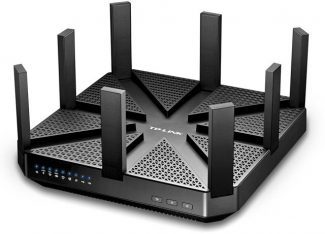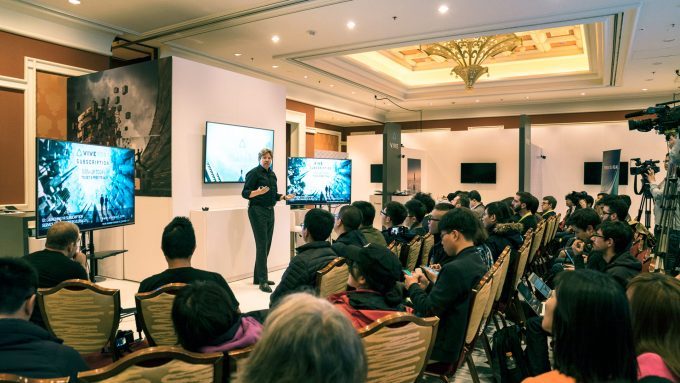HTC have announced that, in addition to its TPCAST wireless add-on, it’s also working with Intel on a WiGig powered wireless VR solution and it’s keen to find more partners to work with on further solutions too.
HTC seems to be ‘all in’ on ensuring its Vive VR headset is well supported for wireless upgrades in order to rid us of those pesky cables. Not content with helping to incubate the development of the soon-to-be-released TPCAST wireless VR solution, HTC announced at its CES press conference this week that semiconductor giant Intel is also working on its own wireless VR solution based on a different transmission protocol.
Update 30th May 2017: HTC have let us know that the new solution developed in conjunction with Intel is taking shape and will be demonstrated to press at this year’s E3 convention due to start June 13th. They state:
“To create this high-end VR experience, Intel and HTC recognized the need to better integrate the HMD with high-computing capabilities. The WiGig technology, based on 802.11ad standard, works solely in the interference- free 60GHz band, and enables high throughput and low latency in both directions, from the PC to HMD and from HMD to PC. This means pristine video quality with <7ms latency in any environment, supporting multiple users sharing the same space. All of this results in the seamless wireless VR with the Vive.”
Road to VR will be at E3 to get some hands on time with the new system.
Original story from Jan 9th 2017 continues below:
Both TPCAST and Intel’s solution both using the same 60Ghz band to broadcast compressed video and input / output data to and from a PC base station, albeit using different standards. The former however has opted to choose the ‘WirelessHD’ standard whilst the latter is going with WiGig.
What’s the Difference Between ‘WiGig’ and ‘WirelessHD’?
Everyone hates format wars, but it seems no shift of any significance happens in the consumer electronics industry without one. Anyone over 40 will recall Betamax versus VHS video tape and then HD-DVD versus Blu-Ray and most recently HDR10 versus Dolby Vision. In this case though, although WiGig and WirelessHD both share some technical similarities they differ in scope and implementation.


WiGig (Intel’s chosen solution) is, as the name suggests, a wireless multi-gigabit networking standard which dramatically increases over-the-air bandwidth over standard WiFi over short distances (the same room). In actual fact, the name ‘WiGig’ is a shortening of the organisation (Wireless Gigabit Alliance) which helped define the IEEE 802.11ad 60GHz standard. WiGig is aimed at very high bandwidth data uses, such as the broadcast of multi-gigabit uncompressed video and audio streams. Although its uses are more limited (short range, doesn’t work well through walls) it is ultimately a very high speed general purpose network standard in the same way as other WiFi standards. Bottom line, if you buy an 802.11ad compatible router, it’ll not only be backwards compatible with your older devices, you’ll be able to use that extra bandwidth for any sort of data transfer, not just video and audio. WiGig data rates max out at 7 gigabits per second per channel.
WirelessHD (TPCAST’s chosen solution) on the other hand is an older standard designed exclusively for the transmission of high definition video over short distances. WirelessHD once again adopts the 60Ghz band and, as of version 1.1 of the standard, can transmit at data rates up to 28 Gigabits per second (much higher than WiGig’s . WirelessHD solutions comprise two boxes, a receiver and a transmitter and each is dedicated to transmitting just video and audio between the source and the destination. Unlike WiGig, you won’t be copying files between devices or browsing the Internet via it. As such, devices that use WirelessHD will likely ship with dedicated receivers and transmitters for use only with that product. WirelessHD (aka UltraGig) is a proprietary standard, as opposed to WiGig’s, which is IEEE standards approved.
Both the above technologies suffer from one of the same issues, inherited from their shared 60Ghz band – namely that it doesn’t deal with line-of-sight blockages (walls, people etc.) well at all. However, both are able to beam-form – that is use walls and ceilings to reflect to avoid occlusion by ‘bouncing’ the signal. You can see why HTC may want to entertain the idea of a WiGig solutions as, despite the maximum bandwidth being lower than WirelessHD, it’s likely we’ll see WiGig routers in people’s homes over the next few years, so a wireless VR product that’s able to work with an existing device will also be cheaper, should the transmitter not be required.
As of now, neither HTC or Intel were ready to share any details about the wireless VR project or any timelines as to when we’d hear more. It’s clear however that HTC are not only keeping their options open as far as wireless VR is concerned they’re actively encouraging technical diversity. To further emphasise this, HTC has indicated it’s interested in hearing from other companies about alternative

